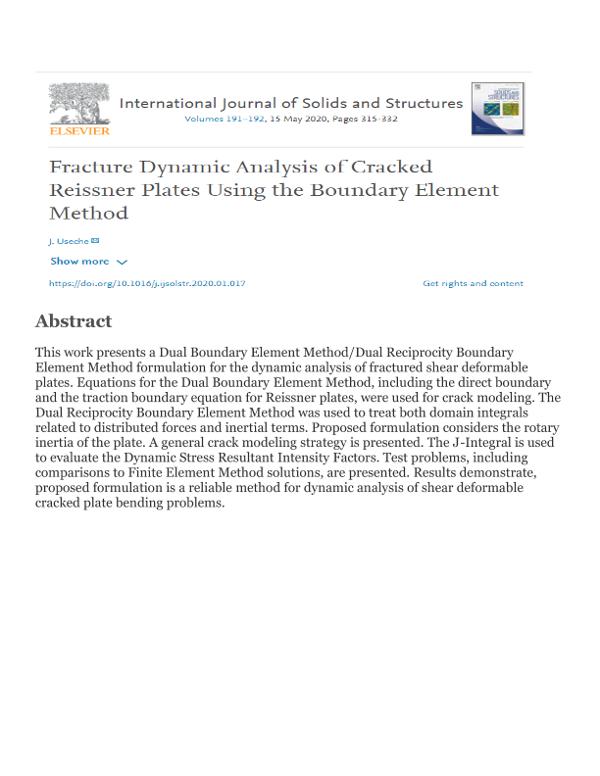Mostrar el registro sencillo del ítem
Fracture Dynamic Analysis of Cracked Reissner Plates Using the Boundary Element Method
| dc.contributor.author | Useche Vivero, Jairo | |
| dc.date.accessioned | 2020-10-30T15:09:56Z | |
| dc.date.available | 2020-10-30T15:09:56Z | |
| dc.date.issued | 2020-05-15 | |
| dc.date.submitted | 2020-10-28 | |
| dc.identifier.citation | Useche, J., 2020. Fracture Dynamic Analysis of Cracked Reissner Plates Using the Boundary Element Method. International Journal of Solids and Structures, 191-192, pp.315-332. | spa |
| dc.identifier.issn | 0020-7683 | |
| dc.identifier.uri | https://hdl.handle.net/20.500.12585/9507 | |
| dc.description.abstract | This work presents a Dual Boundary Element Method/Dual Reciprocity Boundary Element Method formulation for the dynamic analysis of fractured shear deformable plates. Equations for the Dual Boundary Element Method, including the direct boundary and the traction boundary equation for Reissner plates, were used for crack modeling. The Dual Reciprocity Boundary Element Method was used to treat both domain integrals related to distributed forces and inertial terms. Proposed formulation considers the rotary inertia of the plate. A general crack modeling strategy is presented. The J-Integral is used to evaluate the Dynamic Stress Resultant Intensity Factors. Test problems, including comparisons to Finite Element Method solutions, are presented. Results demonstrate, proposed formulation is a reliable method for dynamic analysis of shear deformable cracked plate bending problems. | spa |
| dc.description.tableofcontents | 1. Introduction 2. Plate bending equations 3. Boundary element integral formulation 4. Hypersingular integral formulation for Reissner plates 5. Dual Boundary Element Method 6. Transformation of domain integrals 7. Boundary element discretization 8. Dynamic stress intensity factor calculation 9. Example problems 10. Conclusions | spa |
| dc.format.extent | 18 páginas | |
| dc.format.mimetype | application/pdf | spa |
| dc.language.iso | eng | spa |
| dc.source | International Journal of Solids and Structures; Vol. 191–192, (2020) Pages 315-332 | spa |
| dc.title | Fracture Dynamic Analysis of Cracked Reissner Plates Using the Boundary Element Method | spa |
| datacite.rights | http://purl.org/coar/access_right/c_14cb | spa |
| oaire.version | http://purl.org/coar/version/c_970fb48d4fbd8a85 | spa |
| dc.identifier.url | https://www.sciencedirect.com/science/article/abs/pii/S0020768320300238 | |
| dc.type.driver | info:eu-repo/semantics/article | spa |
| dc.type.hasversion | info:eu-repo/semantics/publishedVersion | spa |
| dc.identifier.doi | 10.1016/j.ijsolstr.2020.01.017 | |
| dc.subject.keywords | Dual boundary element method | spa |
| dc.subject.keywords | Dual reciprocity method | spa |
| dc.subject.keywords | Dynamic cracked plates | spa |
| dc.subject.keywords | Shear deformable plates | spa |
| dc.subject.keywords | J-integral | spa |
| dc.subject.keywords | Reissner plates | spa |
| dc.rights.accessrights | info:eu-repo/semantics/closedAccess | spa |
| dc.identifier.instname | Universidad Tecnológica de Bolívar | spa |
| dc.identifier.reponame | Repositorio Universidad Tecnológica de Bolívar | spa |
| dc.publisher.place | Cartagena de Indias | spa |
| dc.type.spa | Artículo | spa |
| dc.audience | Investigadores | spa |
| oaire.resourcetype | http://purl.org/coar/resource_type/c_2df8fbb1 | spa |
| dc.publisher.discipline | Ingeniería Mecánica | spa |
Ficheros en el ítem
Este ítem aparece en la(s) siguiente(s) colección(ones)
-
Productos de investigación [1453]
Universidad Tecnológica de Bolívar - 2017 Institución de Educación Superior sujeta a inspección y vigilancia por el Ministerio de Educación Nacional. Resolución No 961 del 26 de octubre de 1970 a través de la cual la Gobernación de Bolívar otorga la Personería Jurídica a la Universidad Tecnológica de Bolívar.












